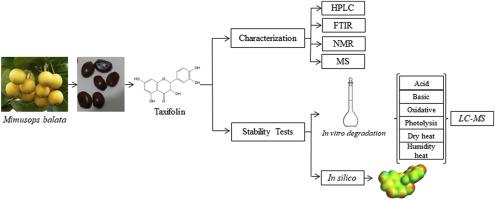Journal of Pharmaceutical Analysis ( IF 6.1 ) Pub Date : 2020-07-06 , DOI: 10.1016/j.jpha.2020.06.008 Fernanda Cristina Stenger Moura 1 , Carmem Lúcia Dos Santos Machado 2 , Favero Reisdorfer Paula 2 , Angélica Garcia Couto 1 , Maurizio Ricci 3 , Valdir Cechinel-Filho 1 , Tiago J Bonomini 1 , Louis P Sandjo 4 , Tania Mari Bellé Bresolin 1

|
Taxifolin has a plethora of therapeutic activities and is currently isolated from the stem bark of the tree Larix gmelinni (Dahurian larch). It is a flavonoid of high commercial interest for its use in supplements or in antioxidant-rich functional foods. However, its poor stability and low bioavailability hinder the use of flavonoid in nutritional or pharmaceutical formulations. In this work, taxifolin isolated from the seeds of Mimusops balata, was evaluated by in silico stability prediction studies and in vitro forced degradation studies (acid and alkaline hydrolysis, oxidation, visible/UV radiation, dry/humid heating) monitored by high performance liquid chromatography with ultraviolet detection (HPLC-UV) and ultrahigh performance liquid chromatography-electrospray ionization-mass spectrometry (UPLC-ESI-MS). The in silico stability prediction studies indicated the most susceptible regions in the molecule to nucleophilic and electrophilic attacks, as well as the sites susceptible to oxidation. The in vitro forced degradation tests were in agreement with the in silico stability prediction, indicating that taxifolin is extremely unstable (class 1) under alkaline hydrolysis. In addition, taxifolin thermal degradation was increased by humidity. On the other hand, with respect to photosensitivity, taxifolin can be classified as class 4 (stable). Moreover, the alkaline degradation products were characterized by UPLC-ESI-MS/MS as dimers of taxifolin. These results enabled an understanding of the intrinsic lability of taxifolin, contributing to the development of stability-indicating methods, and of appropriate drug release systems, with the aims of preserving its stability and improving its bioavailability.
中文翻译:

紫杉叶素稳定性:通过 HPLC-UV/UPLC-ESI-MS 监测进行计算机预测和体外降解
紫杉叶素具有多种治疗活性,目前是从落叶松 ( Larix gmelinni ) 的茎皮中分离出来的。它是一种具有很高商业价值的黄酮类化合物,可用于补充剂或富含抗氧化剂的功能性食品。然而,其稳定性差和生物利用度低阻碍了类黄酮在营养或药物制剂中的使用。在这项工作中,通过计算机稳定性预测研究和高性能液体监测的体外强制降解研究(酸和碱水解、氧化、可见光/紫外线辐射、干/湿加热)对从Mimusops balata种子中分离出的花旗松素进行了评估紫外检测色谱法 (HPLC-UV) 和超高效液相色谱-电喷雾电离-质谱法 (UPLC-ESI-MS)。计算机稳定性预测研究表明分子中最容易受到亲核和亲电攻击的区域,以及容易氧化的位点。体外强制降解试验与计算机稳定性预测一致,表明花旗松素在碱性水解下极其不稳定(1 类)。此外,湿度增加了花旗松素的热降解。另一方面,就光敏性而言,花旗松素可归类为 4 类(稳定)。此外,通过 UPLC-ESI-MS/MS 表征碱性降解产物为花旗松素二聚体。这些结果使人们能够了解花旗松素的内在不稳定性,有助于开发稳定性指示方法和适当的药物释放系统,以保持其稳定性并提高其生物利用度。











































 京公网安备 11010802027423号
京公网安备 11010802027423号